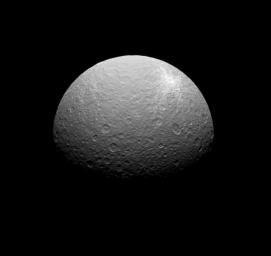
|
Icy Impact
- Click the image above for a larger view
- Full-Res JPEG (926 x 874) (39.9 kB)
- Full-Res TIFF (926 x 874) (810.4 kB)
Caption:
The Cassini spacecraft obtained this view of a bright ray crater on the southern portions of Rhea's leading hemisphere.
The impact that produced the bright rays seen here excavated material from below the surface which is brighter than the surrounding terrain on which it fell.
The image was taken in visible light with the Cassini spacecraft narrow-angle camera on Sept. 26, 2008 at a distance of approximately 463,000 kilometers (288,000 miles) from Rhea and at a Sun-Rhea-spacecraft, or phase, angle of 58 degrees. Image scale is 3 kilometers (2 miles) per pixel.
Background Info:
The Cassini-Huygens mission is a cooperative project of NASA, the European Space Agency and the Italian Space Agency. The Jet Propulsion Laboratory, a division of the California Institute of Technology in Pasadena, manages the mission for NASA's Science Mission Directorate, Washington, D.C. The Cassini orbiter and its two onboard cameras were designed, developed and assembled at JPL. The imaging operations center is based at the Space Science Institute in Boulder, Colo.
For more information about the Cassini-Huygens mission visit http://saturn.jpl.nasa.gov/ . The Cassini imaging team homepage is at http://ciclops.org .
Cataloging Keywords:
| Name | Value | Additional Values |
|---|---|---|
| Target | Rhea | |
| System | Saturn | |
| Target Type | Satellite | |
| Mission | Cassini-Huygens | |
| Instrument Host | Cassini Orbiter | |
| Host Type | Orbiter | |
| Instrument | Imaging Science Subsystem (ISS) | |
| Detector | Narrow Angle Camera | |
| Extra Keywords | Crater, Grayscale, Impact, Visual | |
| Acquisition Date | ||
| Release Date | 2008-12-12 | |
| Date in Caption | ||
| Image Credit | NASA/JPL/Space Science Institute | |
| Source | photojournal.jpl.nasa.gov/catalog/PIA10533 | |
| Identifier | PIA10533 | |
